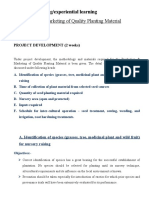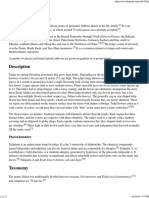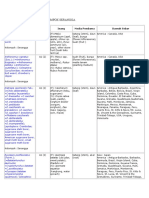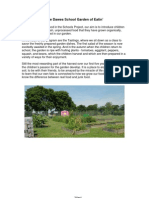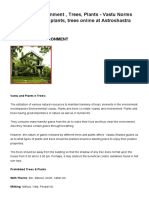GET Horticulture Level 1
GET Horticulture Level 1
Uploaded by
Karen SwanepoelCopyright:
Available Formats
GET Horticulture Level 1
GET Horticulture Level 1
Uploaded by
Karen SwanepoelCopyright
Available Formats
Share this document
Did you find this document useful?
Is this content inappropriate?
Copyright:
Available Formats
GET Horticulture Level 1
GET Horticulture Level 1
Uploaded by
Karen SwanepoelCopyright:
Available Formats
[Registered Qual & Unit Std Home page] [Search Qualifications] [Search Unit Standards]
All qualifications and part qualifications registered on the National Qualifications Framework are public
property. Thus the only payment that can be made for them is for service and reproduction. It is illegal
to sell this material for profit. If the material is reproduced or quoted, the South African Qualifications
Authority (SAQA) should be acknowledged as the source.
SOUTH AFRICAN QUALIFICATIONS AUTHORITY
REGISTERED QUALIFICATION:
General Education and Training Certificate: Horticulture
SAQA QUAL ID QUALIFICATION TITLE
49668 General Education and Training Certificate: Horticulture
ORIGINATOR ORIGINATING PROVIDER
SGB Ornamental Horticulture and
Landscape
QUALITY ASSURING BODY
AgriSETA - Agriculture SETA
QUALIFICATION
TYPE
FIELD SUBFIELD
National Certificate Field 01 - Agriculture and Nature
Conservation
Horticulture
ABET BAND MINIMUM
CREDITS
OLD NQF LEVEL NEW NQF LEVEL QUAL CLASS
Undefined 131 Level 1 NQF Level 01 Regular-Unit Stds
Based
REGISTRATION STATUS SAQA DECISION
NUMBER
REGISTRATION
START DATE
REGISTRATION END
DATE
Reregistered SAQA 0160/05 2009-07-07 2012-06-30
LAST DATE FOR ENROLMENT LAST DATE FOR ACHIEVEMENT
2013-06-30 2016-06-30
In all of the tables in this document, both the old and the new NQF Levels are shown. In the text (purpose statements,
qualification rules, etc), any reference to NQF Levels are to the old levels unless specifically stated otherwise.
This qualification does not replace any other qualification and is not replaced by any other qualification.
PURPOSE AND RATIONALE OF THE QUALIFICATION
Purpose:
This qualification provides learners with a firm foundation of portable skills with which to enter the horticultural
industry in its broadest sense, or if already employed in the industry, be able to look forward to a career path in
any sector of the industry.
A Learner achieving this qualification will be able to work effectively and productively within the field of
horticulture knowing:
z The basic differences between the various plants.
Page 1 oI 8 SAQA
2011/08/22 http://regqs.saqa.org.za/viewQualiIication.php?id49668
z How plants are categorized.
z How to prepare the soil for planting.
z How to grow, handle and care for plants.
z How to apply water to planted areas correctly.
The principles of health and safety are embedded in all the learning aspects of the qualification.
The qualification addresses an urgent industry needs to skill its workforce, to produce and maintain high quality
plants and landscapes.
One of the first impressions that a tourist has of a country, is the beauty of its parks, gardens and sports
facilities. This qualification aims to introduce and consolidate world class standards of horticultural excellence to
enhance South Africa as a tourist destination. The resultant spin-offs will have a positive impact on job creation
and economic empowerment in the country.
Rationale:
This qualification is aimed at those people with limited formal education. It represents a strategic development
in the career and learning pathway of individuals, both from a vocational point of view, as well as from a
learning point of view.
For those wishing to enter the industry, whether they are unemployed or as an Entrepreneur, this qualification
offers a solid foundation of all aspects in the horticultural industry including:
z Landscape construction and maintenance
z Amenity horticulture
z Sportsturf
z Arboriculture
z Plant propagation
z Interior plantscaping
z Retail nurseries
z Floristry
As the core is generic to all the above sectors of the horticultural industry, the qualification embodies the
principle of portability and forms the base for any future learning. Accordingly, this will facilitate the employment
of learners within the industry.
This qualification addresses both the current and future needs of horticulture in South Africa
The qualification is accessible to the learner, in both the urban and rural environs. The varied scope illustrates
the multiple vocations that are available.
LEARNING ASSUMED TO BE IN PLACE AND RECOGNITION OF PRIOR LEARNING
The industry will encourage potential Learners to embark on this qualification as it has universal relevance to the
industry and is nationally recognized. Learners who would like to access this qualification should have
demonstrated competency in Communication and Numeracy at ABET Level 3.
Recognition of prior learning
The qualification may be achieved in part or as a whole through the Recognition of Prior Learning.
RECOGNISE PREVIOUS LEARNING?
Y
QUALIFICATION RULES
This qualification consists of a minimum of 131 credits, composed of:
z Fundamental: 41
z Core: 65
z Electives: 25
EXIT LEVEL OUTCOMES
1. Apply the principles of health and safety in the horticultural environment.
Page 2 oI 8 SAQA
2011/08/22 http://regqs.saqa.org.za/viewQualiIication.php?id49668
2. Understand the structure of plants and the functions of their various components.
3. Demonstrate an understanding of the necessity of water for plant growth.
4. Describe the amount of water to be applied at the most suitable frequency to ensure the healthy growth and
development of plants.
5. Identify the soil types that commonly occur in landscaped areas.
6. Propagate ornamental plants from seed.
7. Conduct the care of ornamental seedlings.
8. Plant and establish ornamental plants from containers into open ground.
9. Mulch and enrich the soil in established landscapes.
ASSOCIATED ASSESSMENT CRITERIA
1.
z The provisions of the health and safety act, as they relate to horticulture are described.
z The duties and responsibilities of employers and employees to provide and maintain a safe working
environment are explained.
2.
z The role of the leaf in the structure and growth of a plant is explained.
z The functions of the roots and stems, in the structure and development of a plant are described.
z The role that the flower has in the reproductive process of a plant is explained.
3.
z The necessity of water for the growth and development of plants is described.
z The factors that affect the water requirements of plants are descried.
z The importance of watering seedlings and newly transplanted material is explained.
4.
z The ideal times and rates of application for watering are described.
z The scheduling of watering to meet the seasonal and climatic conditions are explained.
5.
z The classifications of topsoil and subsoil are explained.
z The various soil types are described.
z The necessity of tilling and enriching the soil before planting is explained.
6.
z The preparation of the seed bed and the manual sowing of seed are demonstrated.
z The monitoring and controlling of the germination environment is described.
7.
z The maintenance and 'growing on' of seedlings is described.
z The 'pricking out' of seedlings and the cultural care, prior to the transplanting stage is described.
8.
z The procedures for the preparation and planting of ornamentals are described.
z The backfilling, firming and leveling of the soil is described.
z The initial care that the plants require is explained.
z The procedures for the preparation and planting of annual is described.
9.
z The materials used in mulching and the benefits derived are described.
z The role that organic material plays in soil enrichment is explained.
z The function of chemical fertilizers in soil enrichment of established plantings is explained.
Page 3 of 8 SAQA
2011/08/22 http://regqs.saqa.org.za/viewQualification.php?id=49668
ntegrated assess ent:
he integrated assess ent allows the earners the opportunit to show that the are a le to utilize concepts
ideas and actions across unit standards. his will allow earners to achieve co petenc that is in eeping with
the purpose oI the qualiIication.
An integrated assess ent will indicate how theoretical learning is de onstrated in a practical environ ent in
such a wa that the application oI the wor learnt eco es second nature.
n conducting an assess ent the qualit oI the perIor ance ust also e evaluated i.e. oth the perIor ance
and the thin ing ehind the action ust e qualitative.
he assess ent should include oth Ior ative and su ative options and should use various assess ent tools
i.e. not o servation onl . t is suggested that a PortIolio oI Assess ent Ior part oI the su ative
assess ent with practical outco es eing de onstrated in a si ulated or real wor place situation.
A road range oI tas orientated and theoretical tools a e used with the distinction etween practical
nowledge and disciplinar nowledge eing aintained.
nit Standards in the qualiIication ust e used to assess the speciIic and ritical ross ield utco es. t is
reco ended that the assess ent tools give earners the opportunit to account Ior their decision a ing and
pro le solving in line with the SpeciIic utco es and related Assess ent riteria.
As a result oI this qualiIication eing generic in Ior ing the Ioundation Ior a career in horticulture earners
should e assessed in occupational conte ts and activities. he assess ent should ensure that the Ioundational
s ills are porta le and prepare the Ior Iurther learning whatever career path the a choose.
INTERNATIONAL COMPARABILITY
o parisons oI the unit standards Iro the nited ingdo Australia and ew ealand indicate si ilarities in
general horticultural practices. owever given the cli atic conditions relative to the countries Iro which the
co parisons were done deviations in content are unavoida le.
he horticultural qualiIications in the nited ingdo and ew ealand egin at level 2 ut uch oI their
content is si ilar to that covered in this qualiIication.
a ples oI co para le qualiIications Iro the nited ingdo include:
z A enit horticulture: 2 reIerence 100 / 2 9 / 8
z Production horticulture: 2 reIerence 100 / 2 92 / 6
z ertiIicate in horticulture: 2 reIerence 100 / 4284 / 2
z ertiIicate in gardening: 2 reIerence 100 / 42 1 /
Australia has horticultural qualiIications Iro level 1. ue to the structure oI their ar ets and their production
ethodologies an oI the unit standards are also used in their agricultural qualiIications.
o ensure porta ilit and general applica ilit the South AIrican level 1 and 2 horticultural qualiIications are
generic. Specialisation into the diverse Iields occurs at level and a ove. Australia however has elected to
specialise Iro level 1.
he Iollowing Australian qualiIications were e a ined and the nota le si ilarities are:
1. egistration o 10298 ertiIicate 1 in orticulture Ar oriculture
z his level 1 qualiIication covers the practices and procedures used in tree esta lish ent and asic pruning.
z an oI the unit standards are used in their other horticultural qualiIications.
z n ter s oI Ar oriculture the South AIrican qualiIication includes asic tree identiIication and cultural
practices.
2. egistration o 10498 ertiIicate 1 in orticulture andscape
z his level 1 qualiIication covers the practices and procedures used in the esta lish ent and aintenance oI
landscapes.
z an oI the unit standards are used in their other horticultural qualiIications.
Page 4 of 8 SAQA
2011/08/22 http://regqs.saqa.org.za/viewQualification.php?id=49668
z In terms of landscaping, the South African qualification follows similar lines, but specific landscaping practices
are included in the electives.
3. Registration No RUH10398 - Certificate 1 in Horticulture (Floriculture)
z This level 1 qualification covers the practices and procedures used in the care and presentation of floral
material, both natural and artificial.
z Many of the unit standards are used in their other horticultural qualifications.
z In terms of Floriculture, the South African qualification has 3 specific floristry unit standards included in the
electives.
4. Registration No RUH10598 - Certificate 1 in Horticulture (Nursery)
z This level 1 qualification covers the principles and practices used in the retail garden centres.
z Many of the unit standards are used in their other horticultural qualifications.
z Specific to this qualification is the merchandising aspects, which are addressed in the South African level 2
electives.
5. Registration No RUH10698 - Certificate 1 in Horticulture (Parks and Gardens)
z This level 1 qualification covers the practices and procedures used in the establishment and maintenance of
landscapes for municipalities and state institutions.
z Many of the unit standards are used in their other horticultural qualifications.
z In terms of large scale landscaping, the South African qualification addresses the same needs and our
terminology for this sector is "Amenity Horticulture" The specific landscaping practices are included in the
electives.
6. Registration No RUH10798 - Certificate 1 in Horticulture (Turf Management)
z This level 1 qualification covers the practices and procedures used in the establishment and maintenance of
large grassed areas, such as golf courses, sportfields and Racetracks.
z Many of the unit standards are used in their other horticultural qualifications.
z In terms of turf grass, the South African qualification includes for the basic mowing and care, but the
specialist establishment and cultural practices are contained in the "Sports Turf" electives.
Summary:
After lengthy discussions, the horticultural SGB and its representative bodies jointly decided that the South
African horticultural industry cannot justify six separate qualifications at level 1 and 2. Accordingly, the
specialisations will be addressed in the electives in one qualification at each level.
ARTICULATION OPTIONS
The generic nature of this qualification and the focus on multi-skilling, will allow articulation within the
horticultural industry sectors of :
Amenity Horticulture, Landscaping, Interior Plantscaping, Garden Design, Sports, Turf, Arboriculture, Floristry,
Floriculture, Plant Propagation, Retail Nurseries and Landscape Irrigation.
As the basics of Agriculture and horticulture are parallel, articulation in the fields of Agronomy, Fruit and
Vegetable Production, Nature Conservation and Forestry are possible.
MODERATION OPTIONS
Anyone assessing a learner against these unit standards must be registered as an assessor with the relevant
ETQA and have experience or in depth knowledge of the horticultural industry.
Any institution offering learning that will enable achievement of these unit standards or will assess these unit
standards must be accredited as a provider with the relevant ETQA. Moderation of assessment will be overseen
by the relevant ETQA according to the moderation guidelines in the qualification and the agreed ETQA
procedure.
Therefore anyone wishing to be assessed against these unit standards may apply to be assessed by any
assessment agency, assessor or provider institution which is accredited by the relevant ETQA.
CRITERIA FOR THE REGISTRATION OF ASSESSORS
Assessors must:
Page 5 of 8 SAQA
2011/08/22 http://regqs.saqa.org.za/viewQualification.php?id=49668
z Be accredited as an assessor by the relevant ETQA.
z Have experience or in depth knowledge of the horticultural industry, specifically as it relates to ornamental
aspects.
z Meet any other requirements that may be stipulated by the relevant ETQA.
z Hold a qualification in Horticulture or Agriculture at NQF Level 2 or higher.
NOTES
N/A
UNIT STANDARDS:
ID UNIT STANDARD TITLE
OLD
LEVEL
NEW
LEVEL
CREDITS
Core 119695 Apply fertilizers to ornamental plants and landscapes Level 1
NQF Level
01
3
Core 119707 Apply health and safety principles in horticulture Level 1
NQF Level
01
3
Core 119702 Apply water to landscaped areas Level 1
NQF Level
01
3
Core 119686 Care for ornamental seedlings Level 1
NQF Level
01
4
Core 119694
Control weeds manually in plant propogation and
landscaping
Level 1
NQF Level
01
4
Core 119687
Demonstrate a basic understanding of the horticultural
industry
Level 1
NQF Level
01
2
Core 119711
Demonstrate an understand of the basic structure of
ornamental plants
Level 1
NQF Level
01
4
Core 119714
Demonstrate an understanding of the role and
requirements of water in plants
Level 1
NQF Level
01
3
Core 119696 Identify and prepare soils for landscaped planting Level 1
NQF Level
01
4
Core 119708
Identify and report common pests and diseases in
plant propogation and landscapes
Level 1
NQF Level
01
4
Core 119689 Identify the major categories of ornamental plants Level 1
NQF Level
01
6
Core 119697 Mow lawns in landscaped areas Level 1
NQF Level
01
3
Core 119703
Mulch and enrich the soil of established landscaped
areas
Level 1
NQF Level
01
5
Core 119706
Plant and establish ornamental plants from containers
into open ground
Level 1
NQF Level
01
5
Core 119704 Propagate ornamental plants from seed Level 1
NQF Level
01
5
Core 119710 Prune and shape ornamental shrubs Level 1
NQF Level
01
4
Core 119698 Utilise growth media for ornamental plant containers Level 1
NQF Level
01
3
Fundamental 7464
Analyse cultural products and processes as
representations of shape, space and time
Level 1
NQF Level
01
2
Fundamental 7451 Collect, analyse, use and communicate numerical data Level 1
NQF Level
01
2
Fundamental 7449
Critically analyse how mathematics is used in social,
political and economic relations
Level 1
NQF Level
01
2
Fundamental 14084
Demonstrate an understanding of and use the
Level 1
NQF Level
1
Page 6 oI 8 SAQA
2011/08/22 http://regqs.saqa.org.za/viewQualiIication.php?id49668
numbering system 01
Fundamental 12203
Demonstrate knowledge of issues relating to HIV and
AIDS
Level 1
NQF Level
01
2
Fundamental 7463
Describe and represent objects and the environment in
terms of shape, space, time and motion
Level 1
NQF Level
01
2
Fundamental 12462
Engage in a range of speaking and listening
interactions for a variety of purposes
Level 1
NQF Level
01
6
Fundamental 12471
Explore and use a variety of strategies to learn
(revised)
Level 1
NQF Level
01
5
Fundamental 12469 Read and respond to a range of text types Level 1
NQF Level
01
6
Fundamental 7461
Use maps to access and communicate information
concerning routes, location and direction
Level 1
NQF Level
01
1
Fundamental 7447 Working with numbers in various contexts Level 1
NQF Level
01
6
Fundamental 12470 Write for a variety of different purposes Level 1
NQF Level
01
6
Elective 119692 Apply basic tree climbing principles Level 2
NQF Level
02
6
Elective 119691
Backfill compact and replant grass sods and plants in
irrigation trenches
Level 2
NQF Level
02
5
Elective 119701 Create an awareness of enviromental protection Level 2
NQF Level
02
4
Elective 119690 Establish an area of turf with grass sods Level 2
NQF Level
02
6
Elective 119699 Excavate irrigation trenches in established landscapes Level 2
NQF Level
02
5
Elective 119705 Handle floristry plant material Level 2
NQF Level
02
5
Elective 119700 Install irrigation piping in trenches Level 2
NQF Level
02
10
Elective 119709 Maintain and conserve the flora in nature areas Level 2
NQF Level
02
5
Elective 119688
Maintain optimal environmental conditions for floristry
arrangements
Level 2
NQF Level
02
5
Elective 119693 Treat floristry plant material Level 2
NQF Level
02
7
LEARNING PROGRAMMES RECORDED AGAINST THIS QUALIFICATION:
NONE
PROVIDERS CURRENTLY ACCREDITED TO OFFER THIS QUALIFICATION:
This information shows the current accreditations (i.e. those not past their accreditation end dates), and is the most complete
record available to SAQA as of today. Some Quality Assuring Bodies have a lag in their recording systems for provider
accreditation, in turn leading to a lag in notifying SAQA of all the providers that they have accredited to offer qualifications and
unit standards, as well as any extensions to accreditation end dates. The relevant Quality Assuring Body should be notified if a
record appears to be missing from here.
1. Aliangy Enterprise cc
2. Bonwelong Skills Development
3. Botsitso Development Service Providers
Page 7 of 8 SAQA
2011/08/22 http://regqs.saqa.org.za/viewQualification.php?id=49668
4. u hunu Providers c
. velelani nstitute Ior S ills evelop ent
6. lu elelisa
. uti a raining and onsultanc
8. gopane rading nterprise
9. hwani rading c
10. iIest le ollege
11. a opane S ills evelop ent Pri ar oorperative td
12. aisha ale a evelop ent Association
1 . edu S ills onsultants
14. opani raining entre
1 . Phophi a shi aho rading nterprise
16. each ut egeta le ultivation raining entre
1 . Seza antu ural Agricultural Pro ects
18. S rading
19. e noIto raining c
20. e o huo usiness S ills Solution
21. huto a Setsha a raininng Services
22. hutopele S ills nstitute
2 . hangona At or c
24. o ano Pro ect anage ent
2 . ashona Pro etcts
All qualiIications and part qualiIications registered on the ational QualiIications ra ewor are pu lic propert . hus the onl
pa ent that can e ade Ior the is Ior service and reproduction. t is illegal to sell this aterial Ior proIit. I the aterial is
reproduced or quoted the South AIrican QualiIications Authorit SAQA should e ac nowledged as the source.
Page 8 of 8 SAQA
2011/08/22 http://regqs.saqa.org.za/viewQualification.php?id=49668
You might also like
- Introduction To Floriculture PDFDocument20 pagesIntroduction To Floriculture PDFLuis Micaller100% (1)
- Interior Plantscaping PDFDocument4 pagesInterior Plantscaping PDFRaniPaviNo ratings yet
- B.Sc. Interior Design & DecorDocument39 pagesB.Sc. Interior Design & DecorvinothiniNo ratings yet
- Nkandla Value Chain AssesmentDocument69 pagesNkandla Value Chain AssesmentKaren SwanepoelNo ratings yet
- What Is PlantscapingDocument44 pagesWhat Is PlantscapingMichaela SantosNo ratings yet
- Concepts of Landscape DesignDocument36 pagesConcepts of Landscape DesignNikilsha KNo ratings yet
- Installing Landscape PlantsDocument40 pagesInstalling Landscape PlantsRarImABigBear023No ratings yet
- 4use of Landscape Elements in Interior DesignDocument34 pages4use of Landscape Elements in Interior DesignSrimathiNo ratings yet
- Landscape Design GuidelinesDocument10 pagesLandscape Design GuidelinesAdithya R SNo ratings yet
- Interior Design and LandscapeDocument37 pagesInterior Design and LandscapeYoha PriyaNo ratings yet
- Landscape ArchitectureDocument12 pagesLandscape ArchitectureIswaryaNo ratings yet
- Vertical Garden - Project ReportDocument4 pagesVertical Garden - Project ReportSubhadeep MitraNo ratings yet
- B.sc. Home Sceince - Interior Design and DecoreDocument77 pagesB.sc. Home Sceince - Interior Design and DecoreDawnNo ratings yet
- Irrigation Management-Mitigation of Water WastageDocument1 pageIrrigation Management-Mitigation of Water WastagebhupsjangirNo ratings yet
- InteriorscapingDocument33 pagesInteriorscapingAarthi ParivallalNo ratings yet
- Landscape Design and Principles 1224810762434493 9Document35 pagesLandscape Design and Principles 1224810762434493 9Jontar MatiusNo ratings yet
- Landscape DesignDocument37 pagesLandscape DesignScott Andrew Serrano100% (1)
- LandscapDocument21 pagesLandscapAAMIR ALINo ratings yet
- Steps in Developing A Landscape DesignDocument12 pagesSteps in Developing A Landscape DesignAesha Upadhyay100% (1)
- Brochure Mobile ApplicationDocument8 pagesBrochure Mobile ApplicationAlok KhuntiaNo ratings yet
- Unit 23 The Interior LandscapeDocument21 pagesUnit 23 The Interior LandscapesNo ratings yet
- Interior PlantscapingDocument52 pagesInterior Plantscapinghyma pdvsNo ratings yet
- Sustainable Landscape Brochure PDFDocument24 pagesSustainable Landscape Brochure PDFRohit VermaNo ratings yet
- Typical Trees With NamesDocument16 pagesTypical Trees With NamesAbu Muhammad Rayyan khanNo ratings yet
- Bakery Cafés in India: An Emerging ConceptDocument2 pagesBakery Cafés in India: An Emerging Conceptanu_satNo ratings yet
- Leed 1Document16 pagesLeed 1Elisha K.No ratings yet
- Planning and Maintenance of OrchardsDocument26 pagesPlanning and Maintenance of OrchardsPriyadarshini BaksiNo ratings yet
- Landscape Report (071barch543)Document13 pagesLandscape Report (071barch543)Srijana ShresthaNo ratings yet
- NATURE INSPIRED INTERIOR Organic Interio PDFDocument28 pagesNATURE INSPIRED INTERIOR Organic Interio PDFsheru kumarNo ratings yet
- Glossary of Landscaping TermsDocument13 pagesGlossary of Landscaping Termsrivzx tamaNo ratings yet
- Group 2 Proposed Botanical and Zoological GardenDocument45 pagesGroup 2 Proposed Botanical and Zoological GardenBalogun Ibrahim100% (1)
- Interior LandscapeDocument23 pagesInterior LandscapedivyaNo ratings yet
- Production and Marketing of Quality Planting Material: Hands-On-Training/experiential LearningDocument30 pagesProduction and Marketing of Quality Planting Material: Hands-On-Training/experiential LearningKanchanNo ratings yet
- Site Planning and Landscape DesignDocument114 pagesSite Planning and Landscape DesignAnitha M RNo ratings yet
- Landscape GardeningDocument3 pagesLandscape GardeningEditor IJTSRDNo ratings yet
- Landscape ArchitectureDocument10 pagesLandscape ArchitecturebobbyNo ratings yet
- Plaza: Access To Features: The Design Team Must Ensure That Landscaping, Level Changes, or OtherDocument9 pagesPlaza: Access To Features: The Design Team Must Ensure That Landscaping, Level Changes, or OtherJavier PereiraNo ratings yet
- Dayananda Sagar School of Architecture: 09 Arc 7.7 Landscape Architecture NotesDocument4 pagesDayananda Sagar School of Architecture: 09 Arc 7.7 Landscape Architecture NotesPrajwal PrakashNo ratings yet
- Plant NurseryDocument9 pagesPlant NurserySonya FlowersNo ratings yet
- Sustainability and Interior DesignDocument3 pagesSustainability and Interior DesigntbeedleNo ratings yet
- Landscaping in InteriorsDocument14 pagesLandscaping in Interiorsharshitha siripuramNo ratings yet
- Interior Design: For The Sparks Album, SeeDocument7 pagesInterior Design: For The Sparks Album, SeebanafshaNo ratings yet
- Trees in KarachiDocument176 pagesTrees in KarachiOmer Yousuf0% (1)
- Climbers and Trees For Villa LandscapingDocument11 pagesClimbers and Trees For Villa LandscapingMonisha100% (1)
- Cut Flowers in IndiaDocument8 pagesCut Flowers in IndiaPunjaji PatilNo ratings yet
- What Is Landscaping?: Flora Fauna Landforms Terrain Shape Elevation Bodies of Water Structures, Buildings FencesDocument18 pagesWhat Is Landscaping?: Flora Fauna Landforms Terrain Shape Elevation Bodies of Water Structures, Buildings FencesJeh UbaldoNo ratings yet
- Roof Top GardenDocument19 pagesRoof Top GardenNeha RajshekarNo ratings yet
- Colour SynopsisDocument11 pagesColour Synopsiszoya mariamNo ratings yet
- Tropical GardenDocument12 pagesTropical Gardentrave rafolsNo ratings yet
- Sample Curricula Bachelor of Science in Interior DesignDocument32 pagesSample Curricula Bachelor of Science in Interior DesignSeaShell_6No ratings yet
- Model Scheme On Setting Up of High Tech Nursery Under Plantation and HorticultureDocument15 pagesModel Scheme On Setting Up of High Tech Nursery Under Plantation and HorticultureSuresh Kumar Vengali100% (1)
- Landscape ArchitectureDocument118 pagesLandscape ArchitectureSurekha DsNo ratings yet
- Grass Introduction (M Baynes) PDFDocument11 pagesGrass Introduction (M Baynes) PDFNovaaa RukmanaNo ratings yet
- Sustainable Communities Lecture OneDocument34 pagesSustainable Communities Lecture OneM Hammad ManzoorNo ratings yet
- The Paradise Garden - A Model For Designing For Those With Dementia and AlzheimerDocument9 pagesThe Paradise Garden - A Model For Designing For Those With Dementia and AlzheimeraldaNo ratings yet
- Landscape Design StyleDocument12 pagesLandscape Design StyleAde KurniawanNo ratings yet
- Floriculture NoteDocument9 pagesFloriculture NotePooja MNo ratings yet
- Interior LandscapeDocument35 pagesInterior Landscapekumara nathanNo ratings yet
- Site Development and Location PlansDocument9 pagesSite Development and Location PlansKenny CantilaNo ratings yet
- Traditional Mediterranean ArchitectureDocument99 pagesTraditional Mediterranean ArchitectureIrma ŠantićNo ratings yet
- Modern Clinic Design: Strategies for an Era of ChangeFrom EverandModern Clinic Design: Strategies for an Era of ChangeChristine Guzzo VickeryNo ratings yet
- Ethnobotany From Namibia Craven and SullivanDocument46 pagesEthnobotany From Namibia Craven and SullivanKaren SwanepoelNo ratings yet
- Diatomaceous Earth For Filter of OilsDocument4 pagesDiatomaceous Earth For Filter of OilsKaren SwanepoelNo ratings yet
- Celery: Apium Graveolens LDocument2 pagesCelery: Apium Graveolens LKaren SwanepoelNo ratings yet
- Essential Oil Express MAY 2024 FINALDocument7 pagesEssential Oil Express MAY 2024 FINALKaren SwanepoelNo ratings yet
- Profile of Essential Oil Industry FAO DAFF PDFDocument111 pagesProfile of Essential Oil Industry FAO DAFF PDFKaren SwanepoelNo ratings yet
- Buchu: Agriculture, Forestry & FisheriesDocument16 pagesBuchu: Agriculture, Forestry & FisheriesKaren Swanepoel100% (1)
- Brochure Cancer Bush PDFDocument2 pagesBrochure Cancer Bush PDFKaren SwanepoelNo ratings yet
- Brochure Aloe FeroxDocument2 pagesBrochure Aloe FeroxKaren SwanepoelNo ratings yet
- Geranium Oil From Pelargonium Var RoseDocument94 pagesGeranium Oil From Pelargonium Var RoseKaren SwanepoelNo ratings yet
- Plight of The Geranium Producer of Oil From Pelargonium Var RoseDocument30 pagesPlight of The Geranium Producer of Oil From Pelargonium Var RoseKaren SwanepoelNo ratings yet
- Lemongrass EO ProfileDocument2 pagesLemongrass EO ProfileKaren SwanepoelNo ratings yet
- Importance of Standards For Natural Products E.G. Essential Oils 2020 KM SWANEPOELDocument27 pagesImportance of Standards For Natural Products E.G. Essential Oils 2020 KM SWANEPOELKaren SwanepoelNo ratings yet
- Want To Learn More? Take Our .: Online Aromatherapy CourseDocument2 pagesWant To Learn More? Take Our .: Online Aromatherapy CourseKaren SwanepoelNo ratings yet
- Market Report SUMMER 2019 SSDocument72 pagesMarket Report SUMMER 2019 SSKaren SwanepoelNo ratings yet
- Steam Distillation Process of Essential OilDocument3 pagesSteam Distillation Process of Essential OilKaren Swanepoel100% (2)
- Southern African Essential Oil Producers Association 2012Document2 pagesSouthern African Essential Oil Producers Association 2012Karen SwanepoelNo ratings yet
- Production Guide For Lemon Balm FINALDocument17 pagesProduction Guide For Lemon Balm FINALKaren SwanepoelNo ratings yet
- Guidelines For Cultivating Ethiopian Lowland BambooDocument68 pagesGuidelines For Cultivating Ethiopian Lowland BambooEverboleh ChowNo ratings yet
- Herbarium Vaarn Vol. IiDocument4 pagesHerbarium Vaarn Vol. IiJoel Martinez100% (1)
- Twonewspeciesof Polyspora Theaceaefrom Vietnamandnewcombinationsforsome AsianspeciesDocument9 pagesTwonewspeciesof Polyspora Theaceaefrom Vietnamandnewcombinationsforsome AsianspeciesVan-Duong DoNo ratings yet
- Chapter 9 Transport in Plants - WorksheetDocument3 pagesChapter 9 Transport in Plants - Worksheetapi-372850890% (10)
- Activity 9 Secondary Growth of Roots and StemsDocument10 pagesActivity 9 Secondary Growth of Roots and StemsGenghis SupnetNo ratings yet
- Glencoe Life Science2Document93 pagesGlencoe Life Science2Cosmina MariaNo ratings yet
- Detailed Lesson Plan in Science 4Document6 pagesDetailed Lesson Plan in Science 4JeremiahNo ratings yet
- Group 3 2Document19 pagesGroup 3 2Lovlegin DiongNo ratings yet
- RodriguezDocument17 pagesRodriguezMeryawaliaNo ratings yet
- Ketahanan Semai Akasia (Acacia Mangium) Pada Variasi Umur TERHADAP INFEKSI Ganoderma SPPDocument6 pagesKetahanan Semai Akasia (Acacia Mangium) Pada Variasi Umur TERHADAP INFEKSI Ganoderma SPPrizky rajabillahNo ratings yet
- TulipsDocument1 pageTulipsglh00No ratings yet
- How Much Oil Can You Press From One Kilo Oil Seeds or Nuts - PITEBADocument4 pagesHow Much Oil Can You Press From One Kilo Oil Seeds or Nuts - PITEBAElisha BaleleNo ratings yet
- Classification of Horticultural CropsDocument14 pagesClassification of Horticultural Cropsmonkey luffy86% (7)
- Daftar Optk Kelompok Serangga: Domesticum (ApelDocument3 pagesDaftar Optk Kelompok Serangga: Domesticum (ApelarifNo ratings yet
- MY PET PLANT GRADE 7 FinalDocument10 pagesMY PET PLANT GRADE 7 FinalVanessa Jane PanhayNo ratings yet
- Plant CycleDocument6 pagesPlant CycleMinistry of GamersNo ratings yet
- Dawes School Community GardenDocument2 pagesDawes School Community GardenKalogeraki DoukaNo ratings yet
- Major Classification of PlantsDocument19 pagesMajor Classification of PlantsJhoy Angeles PinlacNo ratings yet
- Green Sense: The Aesthetics of Plants, Place and Language (NEW BOOK)Document3 pagesGreen Sense: The Aesthetics of Plants, Place and Language (NEW BOOK)TrueHeart Press (Oxford) Ltd.0% (1)
- Nabila Azra Aisyah - 081911433014 - D3 - Luas Minimum Dan Metode KuadratDocument11 pagesNabila Azra Aisyah - 081911433014 - D3 - Luas Minimum Dan Metode KuadratNabila AzraNo ratings yet
- Vastu and Environment, Trees, Plants - Vastu Norms For Environment, Plants, Trees Online at AstroshastraDocument3 pagesVastu and Environment, Trees, Plants - Vastu Norms For Environment, Plants, Trees Online at AstroshastraHemlata LodhaNo ratings yet
- Chapter 9Document1 pageChapter 9api-304486052No ratings yet
- Checklist Bijschrijvingen Bij Import Anders Dan Groenten en FruitDocument531 pagesChecklist Bijschrijvingen Bij Import Anders Dan Groenten en FruitRachNo ratings yet
- Yashodeeps Career AcademyDocument6 pagesYashodeeps Career AcademySamir PathanNo ratings yet
- Cirrculum ViteaDocument2 pagesCirrculum ViteaAzam khan100% (1)
- الاورجفيت مكون صورDocument2 pagesالاورجفيت مكون صورOla SabriNo ratings yet
- Planting Trees and Fruit-Bearing TreesDocument22 pagesPlanting Trees and Fruit-Bearing TreesCyrille LorenzoNo ratings yet
- Science PDFDocument21 pagesScience PDFkanikak97No ratings yet
- Forest Environment-: Tree PhysiologyDocument23 pagesForest Environment-: Tree PhysiologyszscribdNo ratings yet
- Downing TheoryandPracticeDocument470 pagesDowning TheoryandPracticecathrynNo ratings yet
- KIVT Meristem Culture 1Document12 pagesKIVT Meristem Culture 1Azalea SabdariffaNo ratings yet
































